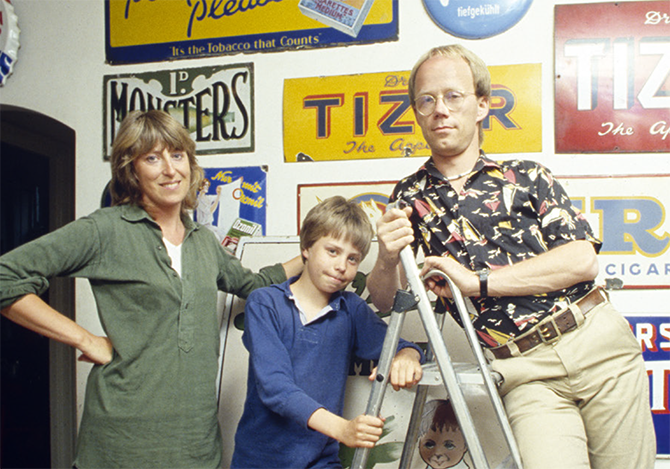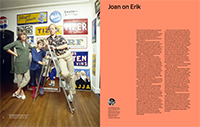
The Spiekermann family Joan, Erik, and Dylan in their London apartment with their collection of enamel signs, 1980.
This week Design Observer celebrates the US release of the new visual biography of Erik Spiekermann, edited by Johannes Erler and published by Gestalten.
The second time I met Erik was at a pre-Xmas party of a mutual friend in Berlin where I was with my then boyfriend. It was 1966, everyone was dressed in student/Carnaby Street/ early hippie garb and Erik was there in a suit, complete with waistcoat and tie. He definitely stood out.
We chatted a bit, then he asked if I was going home to England for Xmas. I said yes, he asked what date and how was I going. I told him; he said he was going on that very flight, so we could travel together! Unbeknown to me he went and booked it next day. That was typical Erik, charming, persuasive, spontaneous, and romantic—I think that every girlfriend since experienced something similar ...
I soon found out about his love of type through that trip to England. We went to the Troubadour in London where he had worked as a busboy for a few weeks and which greatly influenced his love of enamel advertising signs and folk music. The Troubadour, a coffee house started in the 1950s and still there today, had an array of colourful enamel signs decorating the walls and a folk club in the basement where notable musicians such as Bob Dylan played. That was the beginning of his love affair with visual type ephemera, particularly English sign writing compared to German ones.
Years later when we lived in London we started to collect enamel advertising signs we found or bought on our travels, and had about eighty of them on the walls of our flat.
Not long after the trip to London we began to plan a longer trip: we would buy an old car and travel through Europe for a few months. We saved as much as we could from the bit of money we were earning doing odd-jobs, bought an old Citroen 2CV called "Weekend" which we could just about sleep in if we couldn’t pitch the tent, and started to take driving lessons.
My German was proficient enough but the language in the driving manual was a headache and I was struggling to learn the complicated phrases involved in the written test. Erik told me not to worry because if I didn’t pass he would drive us. I learnt my stuff and passed the written and practical test with flying colors. Erik, who thought it would be a breeze, typically failed the written test because he hadn’t bothered to study!
And so we set out on a journey with an old car, and me as the single driver on a brand new license with no experience. Within the first hour while we were on the motorway leaving Berlin, Erik said that my door wasn’t closed properly and I should slam it shut. We were so naive that neither of us thought twice about opening the door at eighty kilometers an hour. The wind nearly took the door off. Shortly after that I put my foot on the brake and I could see the floor beneath me. It was rusted through so badly under the rubber mats that we could almost brake with our feet. So we ended up in Frankfurt at a sculptor’s who had a metal workshop and made us a brand new aluminium floor for the 2CV. We spent weeks in Frankfurt to earn more money for the journey, Erik working for the sculptor; me in restaurants and strawberry-picking until we could move on to cross the Alps into what was then Yugoslavia.
The rest of the journey is for a future chapter! Suffice to say ... we got to know each other claustrophobically well.
When we started to plan FontShop in 1988, I Ieft my job as office manager of an English design company in Berlin to concentrate on this new venture. Erik was working at MetaDesign and applying his time to both projects. We were both convinced that it was a great idea and much needed at the time. What neither of us could imagine was that twenty-five years later it would still be going strong and with many of the early employees still working there. We opened FontShop in February, 1989. In that year we witnessed the Berlin Wall falling and the thrill of closing our offices to go and stand at the Brandenburg Gate with thousands of others. Heady days indeed.
Although the intense working pressure and long hours at FontShop certainly contributed to the break-up of our marriage, I am proud of what we built up and of the fact that we managed to overcome our personal issues and have maintained a strong bond both privately and professionally over the years. Erik is family, along with his wife Susanna. I can’t imagine not having him in my life and am richer through knowing him and having so many shared memories.
 Joan Spiekermann was born in Leigh (Lancashire, England), which she left as soon as she could. She has lived in London, Berlin, San Francisco, and Zurich, and is still trying to settle down.
Joan Spiekermann was born in Leigh (Lancashire, England), which she left as soon as she could. She has lived in London, Berlin, San Francisco, and Zurich, and is still trying to settle down. To download a PDF of this excerpt, click here.
